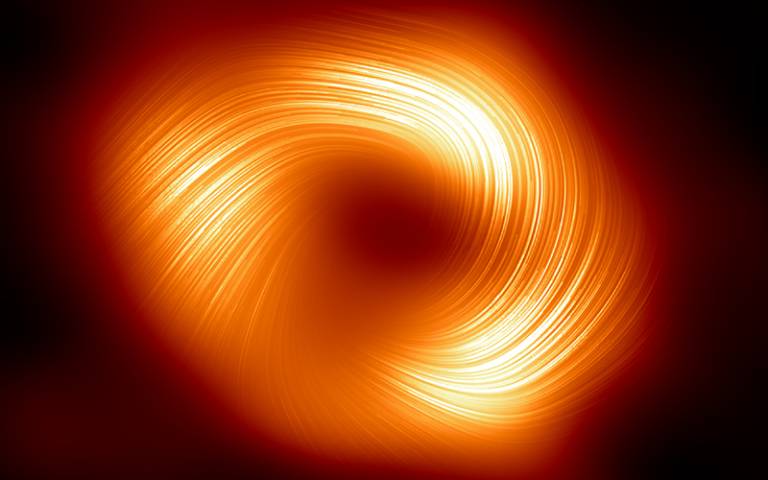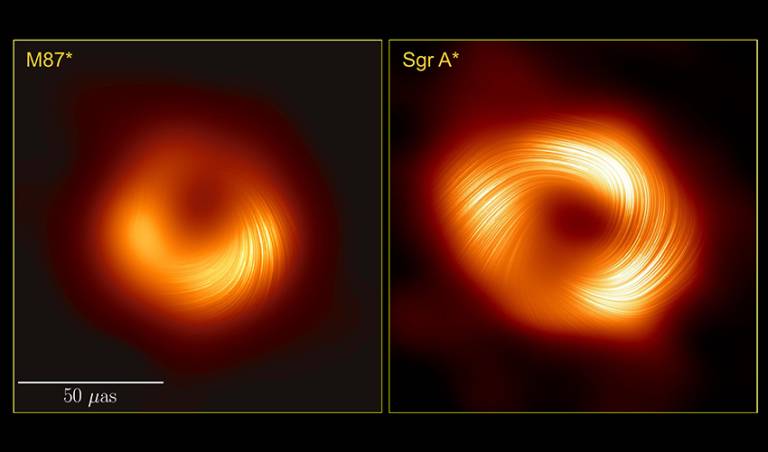New image reveals magnetic fields at edge of Milky Way’s central black hole
27 March 2024
A new image from the Event Horizon Telescope (EHT) collaboration involving ×î×¼µؤءù؛د²تآغج³â€™s Dr Ziri Younsi has uncovered strong and organised magnetic fields spiralling from the edge of the supermassive black hole Sagittarius A* (Sgr A*).

Seen in polarised light for the first time, this new view of the monster lurking at the heart of the Milky Way galaxy has revealed a magnetic field structure strikingly similar to that of the black hole at the centre of the M87 galaxy, suggesting that strong magnetic fields may be common to all black holes. This similarity also hints toward a hidden jet in Sgr A*. The results were published today in The Astrophysical Journal Letters.ج
Scientists unveiled the first image of Sgr A*— which is approximately 27,000 light-years away from Earth — in 2022, revealing that while the Milky Way’s supermassive black hole is more than a thousand times smaller and less massive than M87’s, it looks remarkably similar.
This made scientists wonder whether the two shared common traits outside of their looks. To find out, the team decided to study Sgr A* in polarised light. Previous studies of light around M87* revealed that the magnetic fields around the black hole giant allowed it to launch powerful jets of material back into the surrounding environment. Building on this work, the new images have revealed that the same may be true for Sgr A*.
Dr Ziri Younsi, co-author of the new papers and a member of the EHT Science Council, said: “It is very exciting to see the first polarised images of the black hole in the heart of our galaxy. These observations reveal much more information about the magnetic fields surrounding the black hole, and will improve our ability to model accreting black holes in the future.
“It is remarkable that the polarisation structure of Sgr A* is so similar to that of the M87 black hole, which we know possesses a prodigious relativistic jet. This exciting new study hints at the possibility of a jet hiding near the event horizon of Sgr A*.â€
Dr Sara Issaoun, co-lead of the project from the Center for Astrophysics, Harvard & Smithsonian, said: “What we’re seeing now is that there are strong, twisted, and organised magnetic fields near the black hole at the centre of the Milky Way galaxy.
“Along with Sgr A* having a strikingly similar polarisation structure to that seen in the much larger and more powerful M87* black hole, we’ve learned that strong and ordered magnetic fields are critical to how black holes interact with the gas and matter around them.â€ج

Light is an oscillating, or moving, electromagnetic wave that allows us to see objects.جSometimes, light oscillates in a preferred orientation, and we call it “polarised.†Althoughجpolarised light surrounds us, to human eyes it is indistinguishable from “normal†light.
In theجplasma around these black holes, particles whirling around magnetic field lines impart aجpolarisation pattern perpendicular to the field. This allows astronomers to see in increasinglyجvivid detail what’s happening in black hole regions and map their magnetic field lines.
Dr Angelo Ricarte, project co-lead and Harvard Black Hole Initiative Fellow, said: “By imaging polarised light from hot glowing gas near black holes, we are directly inferring the structure and strength of the magnetic fields that thread the flow of gas and matter that the black hole feeds on and ejects.
“Polarised light teaches us a lot more about the astrophysics, the properties of the gas, and mechanisms that take place as a black hole feeds.â€
But imaging black holes in polarised light isn’t as easy as putting on a pair of polarisedجsunglasses, and this is particularly true of Sgr A*, which is changing so fast that it doesn’t sit still for pictures. Imaging the supermassive black hole requires sophisticated tools above andجbeyond those previously used for capturing M87*, a much steadier target.
The images of both supermassive black holes in polarised light, and the data that come with them, provide new ways to compare black holes of different sizes and masses. As technology improves, the images are likely to reveal even more secrets of black holes and their similarities or differences.
The EHT collaboration involves more than 300 researchers from Africa, Asia, Europe, and North and South America. The international collaboration is working to capture the most detailed black hole images ever obtained by creating a virtual Earth-sized telescope.
The EHT has conducted several observations since 2017 and is scheduled to observe Sgr A* again in April 2024. Each year, the images improve as the EHT incorporates new telescopes, larger bandwidth, and new observing frequencies. Planned expansions for the next decade will enable high-fidelity movies of Sgr A*, may reveal a hidden jet, and could allow astronomers to observe similar polarisation features in other black holes. Meanwhile, extending the EHT into space will provide sharper images of black holes than ever before.
Links
- Dr Ziri Younsi’s REF case study
- Mullard Space Science Laboratory at ×î×¼µؤءù؛د²تآغج³
- ×î×¼µؤءù؛د²تآغج³ Mathematical & Physical Sciences
- ×î×¼µؤءù؛د²تآغج³ News – â€کBlack hole images captured in world first’
- ×î×¼µؤءù؛د²تآغج³ News – 'First image of black hole at centre of our galaxy’
Source
Images
- Top: A view of the Milky Way supermassive black hole Sagittarius A* in polarised light. Credit: EHT Collaboration. ج
- Middle: M87* and Sgr A* side-by-side in polarised light. Credit: EHT Collaboration. Seen here in polarised light, this side-by-side image of the supermassive black holes M87* and Sagittarius A* indicates to scientists that these beasts have similar magnetic field structures. This is significant because it suggests that the physical processes that govern how a black hole feeds and launches a jet may be universal features amongst supermassive black holes.جThe scale shows the apparent size on the sky of these images, in units of micro-arcseconds. A finger held at arm's length measures 1 degree on the sky; a micro-arcsecond is 3.6 billion times smaller than that. In context, the images of these black holes have an apparent size similar to that of .
Media contact
Mark Greaves
T: +44 (0)7990 675947
E: m.greaves [at] ucl.ac.uk
 Close
Close

